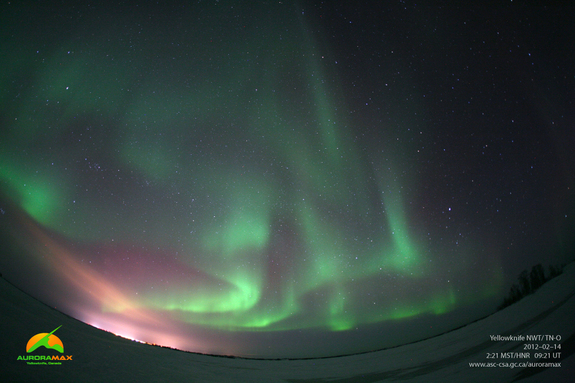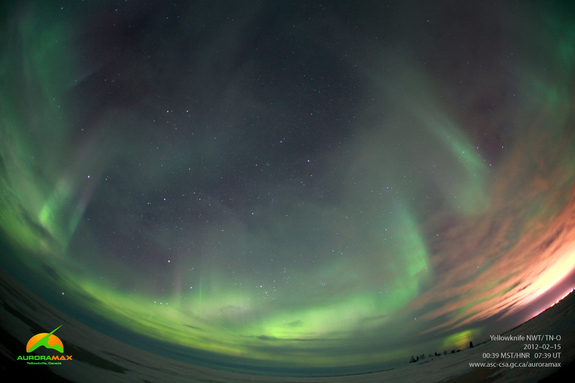
The weird northern lights display began on Valentine's Day (Feb. 14), when an uptick in activity in Earth's magnetic field sparked a geomagnetic storm, according to the skywatching website Spaceweather.com.
"Sometimes the sky surprises us," astronomer Tony Phillips wrote on Spaceweather.com. "On Feb. 14-15, with little warning, geomagnetic activity rippled around the Arctic Circle, producing an outbreak of auroras that veteran observers said was among the best in months."
The Canadian Space Agency's AuroraMAX camera, which records the northern lights and posts them on the Web, snapped several stunning photos of the bright green auroras on Tuesday and Wednesday. Skywatchers also wrote in to Spaceweather.com with their impressions from the northern United States, Sweden, Norway and other northern locales.
According to Phillips, there was some early speculation that a Feb. 10 sun storm, known as a coronal mass ejection (CME), may have triggered the northern lights show, but this solar outburst has not yet been confirmed.

"The reason for the outburst is still not completely clear," Phillips wrote in a post today (Feb. 16). "No CME was obvious in local solar wind data at the time; the disturbance just ... happened."
The sun is currently in an active phase of its 11-year solar weather cycle. The current sun cycle is known as Solar Cycle 24.
This story was provided by SPACE.com, a sister site to LiveScience. Follow SPACE.com for the latest in space science and exploration news on Twitter @Spacedotcom and on Facebook.



By shooting intense radio beams into the night sky, researchers created a modest neon light show visible from the ground. The process is not well understood, but scientists speculate it could one day be employed to light a city or generate celestial advertisements.
Researchers with the High Frequency Active Auroral Research Program (HAARP) project in Alaska tickled the upper atmosphere to the extent that it glowed with green speckles.
The speckles were sprinkled amid a natural display known as the aurora borealis, or Northern Lights. The aurora occurs when electrons from a cloud of hot gas, known as plasma, rain down from space and excite molecules in the ionosphere, about 30 miles (50 kilometers) up.
The HAARP experiment involves acres of antennas and a 1 megawatt generator. The scientists sent radio pulses skyward every 7.5 seconds, explained team leader Todd Pederson of the Air Force Research Laboratory.